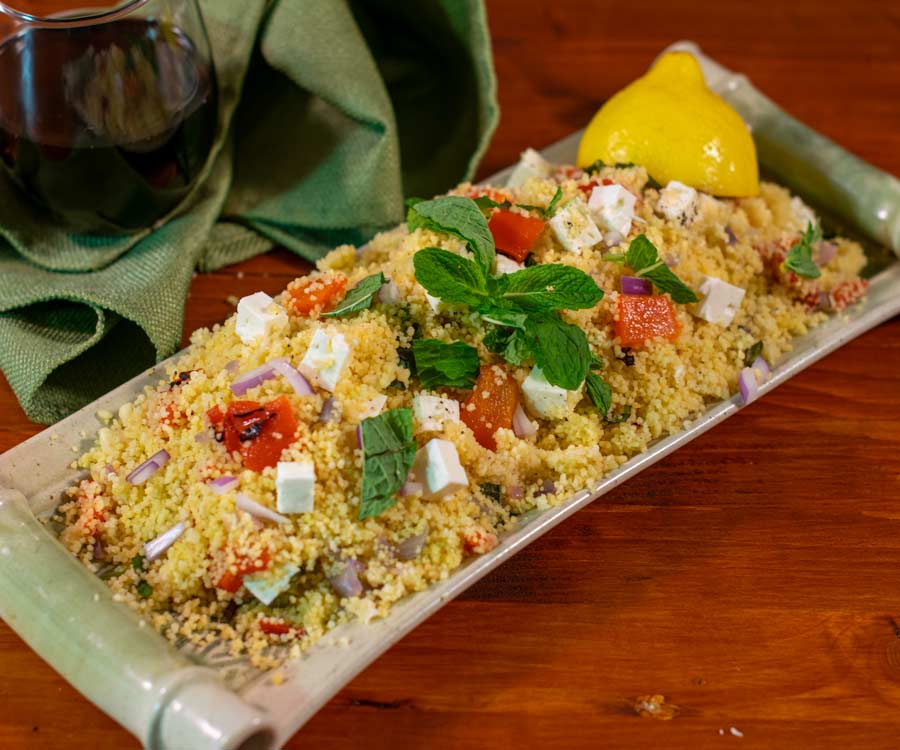Couscous with Roasted Red Peppers and Feta Cheese

An integral component to North African cuisine couscous has grown in popularity to become a pantry staple cooked around the world.
There are many reasons why couscous has become a staple for so many cooks. It’s easy to store, cooks quickly, works with a wide variety of ingredients, and is both healthy and nutritious. It also helps that it can be used as a side dish, a base for stews, part of a salad, and even as a dessert.
For this couscous recipe, we wanted to develop a dish with bright Mediterranean flavors that went well with grilled dishes like spit-roasted leg of lamb or a delicious grilled pork tenderloin but could also stand on its own.

What makes this recipe so good is how the sweetness of the roasted red peppers, the saltiness of the feta, and the pop of fresh mint come together.
What is couscous
The traditional way to make couscous is from semolina flour which comes from Durham wheat. The flour is sprinkled with water and rolled to form small balls that are run through a sieve until they’ve reached the desired size. The couscous is then dried and cooked by steaming.

Making couscous by hand is a very labor-intensive process, which is why most couscous sold today is made by machine and is pre-steamed and dried so it can be cooked quickly at home.
This type is often referred to as instant or quick couscous. You can see how it’s made in this mildly entertaining video. Most of what is sold in grocery stores are the instant variety that has been pre-steamed and dried, allowing it to be cooked quickly on the stove or in the microwave.
The three most common types of couscous are Moroccan, Israeli, and Lebanese, with Moroccan and Israeli being the most common in the States. Israelis or pearl couscous is similar to Moroccan except it is larger and resembles small pieces of pasta. Lebanese is the largest of the three and takes the longest to cook.
Because it’s made with crushed wheat it has a similar nutritional profile as pasta, with the whole wheat variety having some additional health benefits compared to the regular variety. It also contains gluten making it unsuitable for anyone with gluten intolerance.
Learn How to Cook Couscous
When it’s cooked properly, couscous should turn out light and fluffy with a slight chew. A sign that it’s been cooked too long is when it turns out sticky and mushy. It’s the type of ingredient that anyone can learn how to cook.
Couscous is typically cooked using a ratio of 1.5 cups of liquid for every 1 cup of couscous.

The cooking liquid can be stock or water, which is brought to a boil before the couscous is added. Once it’s been added and stirred, the pan is covered tightly and removed from the heat for five minutes.
When it’s finished cooking it’s fluffed up using a spoon or fork to help break up clumps and to aerate the dish. We’ve found that using a large wooden spoon is the best tool for this step.
Storage & Reheating
Couscous should be stored in a well-sealed container in the pantry. Once it’s been cooked it will keep in the refrigerator for four or five days.
The best way to reheat it’s in a saute pan with a little water or stock that has been brought to a boil. The couscous should be stirred regularly while it’s being reheated and stay in the pan until it’s been warmed through.
How to Season Couscous
Couscous itself has a mild neutral flavor with a slight hint of nuttiness that allows it to absorb and transport the flavors of the things it’s cooked and served with.
In North African cooking couscous is often served with vegetables cooked in a broth or as the base for a stew that is ladled over the top. It can also be served at the end of the meal or as a dessert.
To develop a recipe with vibrant flavors that highlight the ingredient we start by sauteeing the onion, garlic, and roasted red peppers in the same pan the couscous is going to be cooked in.
Once everything is where we want it, we add a flavorful chicken or vegetable stock to the pan and bring it to a boil to infuse the couscous with the other ingredients’ flavors.
To round the dish out, we add fresh mint and feta that add bright herb notes and a touch of saltiness. One of the great things about this recipe is how simple and quick it is to make.
Couscous with Roasted Red Peppers and Feta Cheese
Ingredients
- 2 cups couscous
- 3 cups stock, chicken or vegetable
- 1 tbsp butter
- 1/3 cup red onion, diced
- 1/2 cup roasted red pepper, diced
- 1 clove garlic, minced
- 2 oz feta cheese, cubed
- 1/3 cup mint, chiffonade
- 2 tsp lemon juice
- 1/2 tsp salt
- 1/4 tsp pepper
Instructions
- Start by prepping all the ingredients.
- In a large pan, sauté the red onion, garlic, and roasted red pepper in a little butter or olive oil for 2 to 3 minutes.
- Add the stock to the pan and bring it to a boil.
- Add the couscous, stir everything together, cover tightly, and remove from the heat for five minutes.
- When it has finished cooking, use a spoon to fluff the couscous while adding the salt, pepper, lemon juice, feta cheese, and mint as you stir.
Mark is an experienced food writer, recipe developer, and photographer who is also Umami’s publisher and CEO. A passionate cook who loves to cook for friends, he can often be found in the kitchen or by the grill testing new recipes.
More Info About Mark Hinds
Learn More
Find more recipes, tips, and ideas about these techniques, ingredients, and cuisines.













Leave a Reply